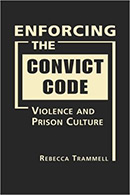Enforcing the Convict Code: Prison Violence and Prison Culture
 Author: Rebecca Trammell
Author: Rebecca Trammell
Publisher: Boulder, CO: Lynne Rienner Publishers, 2012. 157p.
Reviewer: Patricia Hardyman │ January 2013
Enforcing the Convict Code takes on critical questions of institutional culture within a US correctional system. The book is valuable as a different look at prison violence and culture from analyses of administrative records and/ or reports. Former inmates from the California adult prison system (California Department of Rehabilitation and Corrections – CDCR) told their stories and described their daily lives, the so-called “convict code,” and strategies for coping with institutional life. To no surprise, the inmates described prison life as boring with many hours spent doing nothing, playing cards, etc. The inmates reported that violence is NOT the primary problem in prison, but rather it is bad food and inadequate medical and dental care. Violence among male inmates was a common strategy for controlling other inmates that did “bad time, ” i.e., bringing unwanted attention from CDCR staff and increasing the risks of riot and/or risk of the prison being “locked down.” Violence among women, on the other hand, was a strategy of last resort.
A major contribution of this book to the literature on prison culture and violence is the gender-specific comparison and contrast of prison violence and the inmate code. Critical differences are reported in the roles of race, gangs (both street and prison), and sexual predation by the men and women. In short, segregation by race and gang membership are very important to the male institutional culture; while for the women, race, street gang membership, and prison culture are not necessarily linked.
The strength of the book is also its’ major weakness. As Trammell indicates, “California is an interesting place to study prison violence.” She highlights the facts that the CDRC is one of the largest systems in the U.S., houses some the most notorious and violent prison gangs, and is under state and federal court orders regarding overcrowding and medical/mental health services. But these factors all diminish the reader’s ability to generalize from Trammell’s work to any of the other U.S. correctional systems. Systems not laden with racial tensions, gangs, and crowding and/or that provide a more complete array of services and programming might have very different prison cultures. This critical point is missing from her conclusions. Prison culture and violence systems are painted as bi-dimensional – male versus female — differences across jurisdictions or even among CDRC prisons by security level. These are narratives yet to be told. While inmates struggle with boredom and the desire for control of their daily lives, the norms of the inmate cultures and the roles of violence may well differ across and within correctional systems as evidenced by dramatically different official rates of predatory behaviors within and across correctional systems.
Patricia L. Hardyman, Ph.D.
Principal
Criminal Justice Institute, Inc.
967 Hartsville-New Marlboro Rd
New Marlborough, MA 01230


